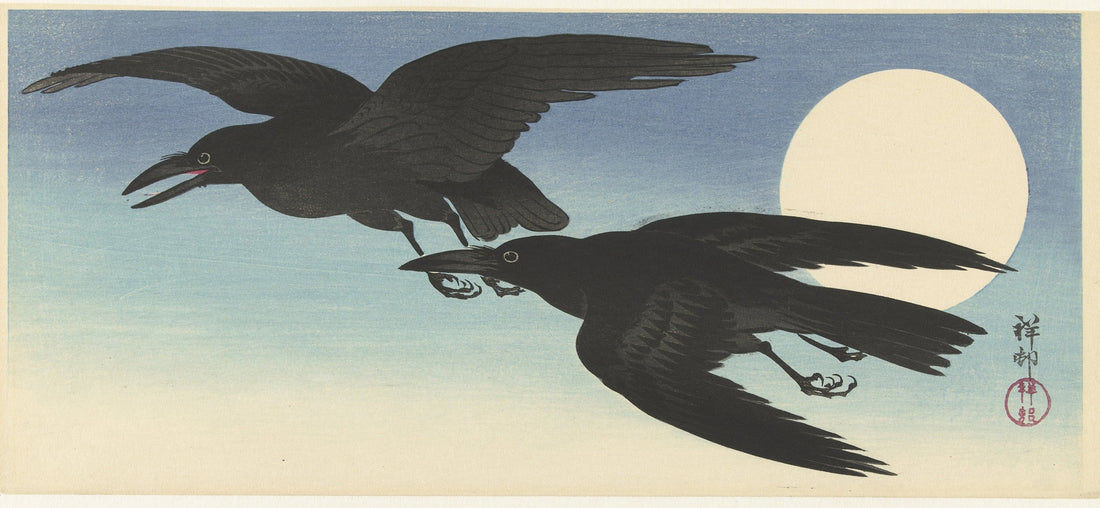
Inviting Crow to a Conversation
Crow has woven through our story ever since we humans first walked the land. They have been in our myths and legends and in our holy books. As civilizations came and went, the image of the crow has stood silent on cave walls buried deep within the earth and deep within our consciousness.

Their brains are bigger than ours. Not in mass, but in the size of the brain itself in relation to the size of our bodies—the relationship that’s important to the scientists who study them. And it isn’t just the size that matters. It’s also the part of the brain that is so well-developed. It’s the part of the brain that identifies patterns, that sees faces and remembers them. They can count and are adept, not only at using tools, but in shaping them as well.
There are all kinds of websites that discuss the breadth of the spiritual meaning of crows, and I encourage you to check them out. Here I’d like to focus on the crow’s human-like ability to recognize patterns. It’s that ability that helps them connect with us and us with them. To learn from them—not just about them, but about ourselves.

Crow is a guide to deep transformation. They watch us from treetops. They watch us come and go. They see how we treat our pets, the people in our lives, how we move throughout the day. They see how we walk on the earth. Whether we are in or out of balance with the laws of the Great Spirit. All the time, sizing us up. Deciding if we are friend or foe. If we feed them, they sometimes bring us gifts in return.
If they trust you, they may come close. In my blog about my dog, Lola, I tell of their trust in me to take care of their babies while I worked in my garden, and they went about their business.
If you talk to them, they will listen. Some will even talk back. But you don’t need human language to communicate with them, to receive their lessons about change, about transformation.
As anyone awake can feel, we are in a time of great change in the world. Sometimes it feels like it comes at us with a firehose. Many of those changes are external. But others are very much internal. The crow models for us a way to open ourselves to our soul growth. In turn, our internal world transforms the external.
Just as the crow looks down at us from the treetops, as they recognize our patterns, they call on us to look at ourselves as they do—from a distance. It is from that distance that we can see our own patterns. Patterns of thinking and behavior that may have become too habitual for us to recognize that they no longer serve us. That we may need to explore new ways.
Crow teaches detachment. We cannot make change without first detaching from thoughts and habits that aren’t working. Before we can be filled with the new, we must release the old and outworn.
In shamanic traditions, this is sometimes called the point of assemblage. To be able to shift our perception of ourselves to see ourselves more clearly, leads to being able to shift our perception of the world. This is how the world transforms.
"A real conversation always contains an invitation. You are inviting another person to reveal herself or himself to you, to tell you who they are or what they want."
Invite the crow into a conversation. Ask Crow to reveal themselves to you. To tell you who they are, and what they want you to know.
Watch them. Sit with them. Listen to them. Bring them into your home. Not in the way of taking a wild animal inside for they belong in the wild. But through study. Through image. Though poetry. Through dance. Through inviting them to your meditation.
My own meditations about Crow have given birth to an image I share with you. That you can hold, that you can carry with you as you go about your days. That simple act of carrying their image with you can be quite powerful.
Then, as always, I encourage direct interaction with these magical birds. Here are some tips for creating your own connection to the crows who share your space.
Inviting Crow to Your Conversation
- Get to know crows. Learn about their habitats, their seasons, their sleep and wake cycles.
- Observe, watch, and listen. Try to identify your resident crow couple.
- Crows breeding season varies a bit by their location, but in the United States as in most of the world, their babies arrive with spring—in April through June. Because they are family oriented, much as we are, their babies stay with them well into adulthood, with siblings pitching in to help with the newborns.
- Go about your business in your yard, sit quietly and read, or just soak up the sun. If you don’t have a yard, try your local park or open space. Just don’t look at them straight on. Our eyes, at the front of our heads, are like predators’ eyes. To make them comfortable, look at them from the side.
- When you feel they are ready, put food out for them and then leave. They are quite shy and will take a while to learn to trust you. As they get to know you better, you can sit outside at a distance from them. Take it slow. If you lose their trust, you may not get it back—crows remember and they are known to hold a grudge.
- Remember that crows will eat anything. Even things that aren’t good for them. A bit like humans.
- Don’t feed them junk food, or anything salted. No chocolate, no dairy, no seasonings. No apple seeds. No avocados.
- Do feed them wet or dry dog food, eggs (scrambled are a favorite, unsalted and unseasoned, of course). Seeds, fruits, table scraps (again, unsalted), meats like chicken and beef, fish, nuts and peanuts.
- And don’t forget about water—especially if there aren’t good sources nearby and when it’s hot.
- Try to be regular when it comes to visiting them or feeding them. Same place, same time. And don’t overfeed them—a handful a day is plenty. They are wild animals and you don’t want them to be reliant solely on you.
- After they get to know you, and you them, you can begin to talk to them quietly. You may also get them to eat out of your hand—but that will take time and trust!
To view our Crow Collection, click here.
Recommendations
In my exploration, I was guided by this lovely book, The authors are scientists who have extensively studied the crow from their discipline as scientists, and in doing that have encountered marvelous and magical stories about crow relationships to humans. Rather than retell those stories here, I encourage you to go to the source. It is a delightful read that is also available as an audio book.
For crow and many other animals. A deck of cards and a book explaining their meanings from a Native American perspective. These have been my constant companion for decades. Insightful, beautifully written and illustrated.
Enjoy your journey with Crow!
Pat

